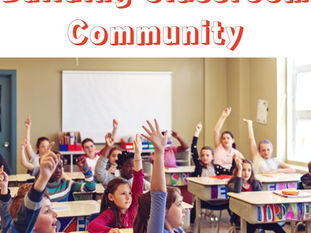Teacher Mode

Effective Classroom Management Strategies for Primary Teachers
Sep 4, 2024
4 min read
0
43
0
As primary school teachers, one of the most important aspects of our jobs is effective classroom management. A well-managed classroom sets the tone for a productive and positive learning environment, where students feel safe, engaged, and ready to learn. In this post, we will discuss some valuable classroom management strategies that primary teachers can implement to create a successful and harmonious classroom.

Effective Classroom Management Strategies
1. Establish Clear Expectations
Setting clear and consistent expectations from the start is key to managing a classroom effectively. Establish rules and routines that are easy for students to understand and follow. Be sure to communicate these expectations regularly and reinforce them when necessary. Having visual aids like posters with classroom rules can help students remember them throughout the year.
Tips for Success:
Use simple, concise language when explaining rules.
Post rules in a visible spot and review them regularly.
Reinforce expectations with class discussions and role-playing activities.
Use a book to help establish rules from day one.
2. Build Positive Relationships
Building positive relationships with your students is crucial for effective classroom management. Take the time to get to know each student individually, show empathy, and create a supportive and inclusive classroom community. When students feel valued and respected, they are more likely to behave positively.
How to Build Strong Relationships:
Greet students at the door every morning.
Hold regular "check-in" conversations to see how students are feeling.
Create a class community with team-building activities.
Use a morning meeting to help build classroom community.
3. Use Positive Reinforcement
Positive reinforcement is a powerful tool for encouraging good behavior in the classroom. Recognize and praise students for following rules, participating, and showing positive attitudes. This can be as simple as verbal praise, stickers, or small rewards to reinforce desired behaviors.
Ideas for Positive Reinforcement:
Create a "Student of the Week" program to highlight positive behavior.
Use a points system where students earn rewards for teamwork or participation.
Offer praise in front of the class to motivate others.
Use small stickers, pencil toppers or other small prizes to reward students.
4. Implement Effective Transitions
Smooth transitions between activities can help maintain a sense of order and keep students on task. Provide clear instructions, use visual cues or timers, and establish routines for transitioning between activities to keep students engaged and focused. Transitions are a time when many disruptions can occur, so having a structured system in place is key.
Transition Tips:
Use a large visual timer or music to signal when it’s time to transition.
Have students practice transitions at the beginning of the year to set the tone.
Create simple routines for common transitions, such as cleaning up or moving to a new center.
5. Manage Student Behavior Proactively
Anticipate potential challenges and have strategies in place to address them before they escalate. Use proactive strategies such as proximity control, non-verbal cues, and redirection to prevent disruptive behavior and maintain a positive learning environment. Addressing issues early helps prevent larger disruptions and keeps the class focused on learning.
Proactive Behavior Strategies:
Stand near students who seem distracted to regain their focus.
Use signals like raising your hand, striking a chime or ringing a bell to gain attention without raising your voice.
Redirect misbehavior by offering alternative tasks or choices.
6. Utilize Classroom Rewards Systems
Implementing a classroom rewards system can motivate students to follow rules and stay engaged in their learning. Consider using a token economy system, a class-wide reward system, or individual behavior charts to encourage positive behavior and academic growth. Rewards systems can be both fun and motivating for students, while also reinforcing good habits.
Reward System Ideas:
Use a class jar where students can earn marbles or tokens for good behavior, and reward the class once the jar is full.
Create individual sticker charts to track student achievements.
Offer small group rewards, such as extra recess or a class party, to encourage teamwork.
7. Incorporate Mindfulness and Calm-Down Strategies
Introducing mindfulness techniques and calm-down strategies helps students regulate their emotions and behavior. Teaching students how to calm themselves during stressful moments can prevent outbursts and promote a more peaceful classroom environment. Incorporate short breathing exercises, meditation, or quiet reflection time into your daily routine.
Mindfulness Activities:
Teach students simple breathing exercises or stretching techniques.
Create a "calm-down corner" with sensory tools or books where students can go to reset.
Use brain breaks to help students refocus between lessons.
8. Create a Strong Classroom Routine
Routines are essential for young learners as they provide a sense of structure and security. From morning meetings to end-of-day clean-up, having clear and predictable routines minimizes confusion and helps students understand what is expected of them.
Routine Ideas:
Begin the day with a consistent morning routine, such as reviewing the schedule or doing a quick mindfulness activity.
Establish procedures for common tasks like handing out materials or lining up.
Have a predictable dismissal routine to end the day calmly and orderly.
9. Use Visuals and Non-Verbal Cues
Many students respond well to visuals and non-verbal cues that help them understand expectations without needing verbal instructions. Picture schedules, classroom signals, and visual timers can help students follow routines and stay on track.
Visual Management Tools:
Create picture schedules to show students what to expect throughout the day.
Use hand signals or classroom signs to communicate non-verbally (e.g., a raised hand for silence).
Incorporate visual timers to manage time during activities.
By implementing these classroom management strategies, primary teachers can create a positive and productive learning environment where students can thrive. Remember, effective classroom management is a skill that takes time to develop, so be patient with yourself and your students as you work towards a well-managed classroom. With clear expectations, positive reinforcement, and structured routines, you can foster a space where both teaching and learning are enjoyable for everyone.










